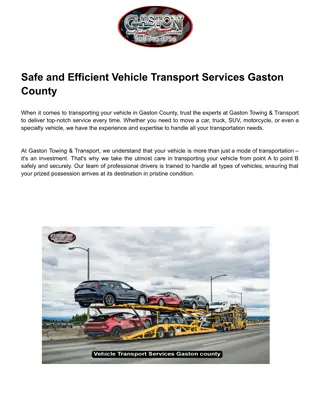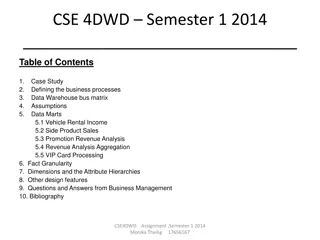Insights on US Vehicle Sales in 2017
The US vehicle sales data for 2017 showcases trends in light-vehicle sales, dealership profits, truck sales, and service revenue. Discover key insights on major auto brands, dealership performance, and the impact of trucks on the industry.
Download Presentation

Please find below an Image/Link to download the presentation.
The content on the website is provided AS IS for your information and personal use only. It may not be sold, licensed, or shared on other websites without obtaining consent from the author.If you encounter any issues during the download, it is possible that the publisher has removed the file from their server.
You are allowed to download the files provided on this website for personal or commercial use, subject to the condition that they are used lawfully. All files are the property of their respective owners.
The content on the website is provided AS IS for your information and personal use only. It may not be sold, licensed, or shared on other websites without obtaining consent from the author.
E N D
Presentation Transcript
2017: The Last, Best Year? Total 2017 US light vehicle sales were a very respectable 17.24-million units, 1.7% fewer than 2016 s record year, but exceeding 17 million units for the third consecutive year. Early-2018 forecasts indicate, however, a decrease of 2.9%, to 16.7 million units. Of the major auto brands, Infiniti recorded the largest unit sales increase during 2017, or 10.9%; followed by Audi, +7.8%; Mitsubishi, +7.7%; Subaru, +5.3%; Volkswagen, +5.2%; and GMC, +2.6%. Among the top-5 brands, only Honda, +0.7%, and Nissan, +1.0%, increased their unit sales for 2017, while Ford decreased 1.1%, Chevrolet, 1.5%; and Toyota, 0.6%.
Average Dealer Still Delivering Significant Profits According to the National Automobile Dealers Association (NADA) 2017 Mid-Year (January June) Report, the average light-vehicle dealership s total sales decreased very slightly, $29.43 million, compared to $29.46 million for January June 2016. By November 2017, however, the NADA data for the first 11 months of the year revealed a 0.6% increase for the average light-vehicle dealership, or $54.35 million, compared to $54.03 million for the first 11 months of 2016. Net profit before tax as a percent of total sales for the January November 2017 period were approximately the same as the January November 2016 period, or +2.4% and +2.5%, respectively.
Mass-Market Dealerships Outperform Other Dealership Categories Of the four sub-markets in the NADA Average Dealership Profile for January November 2017, only mass-market dealerships had positive total sales, at 0.7%. Domestic dealerships were 0.0%; imports, -2.9%; and luxury, -8.1%. When the metric was net profit before tax as a percent of total sales, all four sub-markets were positive: luxury, +2.8; import, +2.6%; mass-market, +2.4%; and domestic, +2.2%; however, their total net profit before tax was less than 2016. Only the mass-market sub-sector recorded an increase in new-vehicle department total sales, comparing January November 2017 to January November 2016, or +0.7%, while domestic dealerships were -0.6%; imports, -3.3%; and luxury, -10.4%.
Trucks Keeping the Industry Between the Lines As the table on page 2 of the Profiler indicates, 2017 light-duty truck sales saved the industry s bacon for the year. Of those total light-duty truck sales, full- and mid- size pickup trucks totaled 2.8 million units, or a 4.8% increase from 2016. During 2017, pickup trucks represented a 16.4% share of all US light-vehicle sales. Ford s F-Series full-size pickup truck models sold almost 900,000 units while total units of all General Motors pickup models sold were approximately 950,000. For the commercial-truck market, NADA reported a total of 415,042 medium- and heavy-duty truck sales, a 3.8% increase from 2016, with medium-duty increasing 7.6%, but heavy-duty decreasing -0.2%.
Plenty of Work for Parts & Service Service, parts and body shop work are major sources of revenue for car dealerships. According to NADA, combined, they accounted for 48.9% of total gross sales and 12.2% of total sales at the average US dealership for the January November 2017 period. In a February 2018 article, Automotive News reported that there will be 241 cars and light-duty trucks on US roads for each dealer service bay by mid-2018. In addition, an estimated 68.3 million vehicles will be off warranty during the 2018 2020 period. Dealerships service departments are expected to be kept busy through spring 2018, as the top weather-related car accidents (2005 2014) were wet pavement, rain, snow/sleet, snowy pavement, icy pavement and fog.
Tech Is Tailgating Our monthly Automotive Update Reports devote considerable space to electric and autonomous vehicles and associated technologies, but many vehicles, as early as 2019 for Ford models, will have 100% connectivity, transforming them into a mobile device. Dealerships are faced with the challenge of needing two separate service channels and additional technician training and tools, as consumers buy more electric vehicles while many vehicles with internal-combustion engines will remain on the road. Telecommunications companies are about to start the transition from 4G to 5G connectivity, which will be vital for the huge surge in data that autonomous vehicles must share to operate safely, efficiently and in unison.
Advertising Strategies As noted in more than one of our monthly Automotive Update Reports, the car dealerships that transition from the featured model/price TV commercial message to one that drives more consumers to their Websites are likely to sustain and build their brand. Since parts and service are responsible for almost 50% of the average dealerships revenues, their marketing and advertising, regardless of the media, should continue to tout the professionalism and skills of the service staff and its customer conveniences. With many experts predicting the total disruption of the dealership business model, dealers with the flexibility and foresight to adjust are more likely to survive; and, as the changes occur, must use their ad dollars to position themselves as leaders of the new model.
New Media Strategies As digital natives (Gen Zers and Millennials) age and become dealerships primary customer base, it s extremely important that dealers move more of the buying process to their Websites, including F&I forms, etc., and make sure they are mobile-friendly. Dealers should consider creating explainer videos of new tech features on the latest models, both to capture more younger consumers who prefer video content and to be known as the dealerships that are the new-tech leaders in their market. Dealerships will do much to humanize their brand/image by being very active in community projects, including employee volunteerism. All of these efforts and events should become videos for social media posting and to encourage customer participation.























